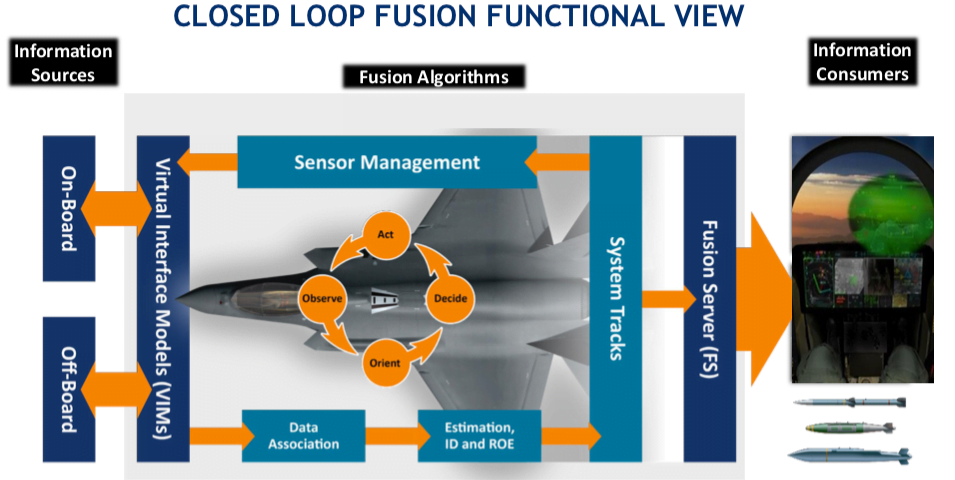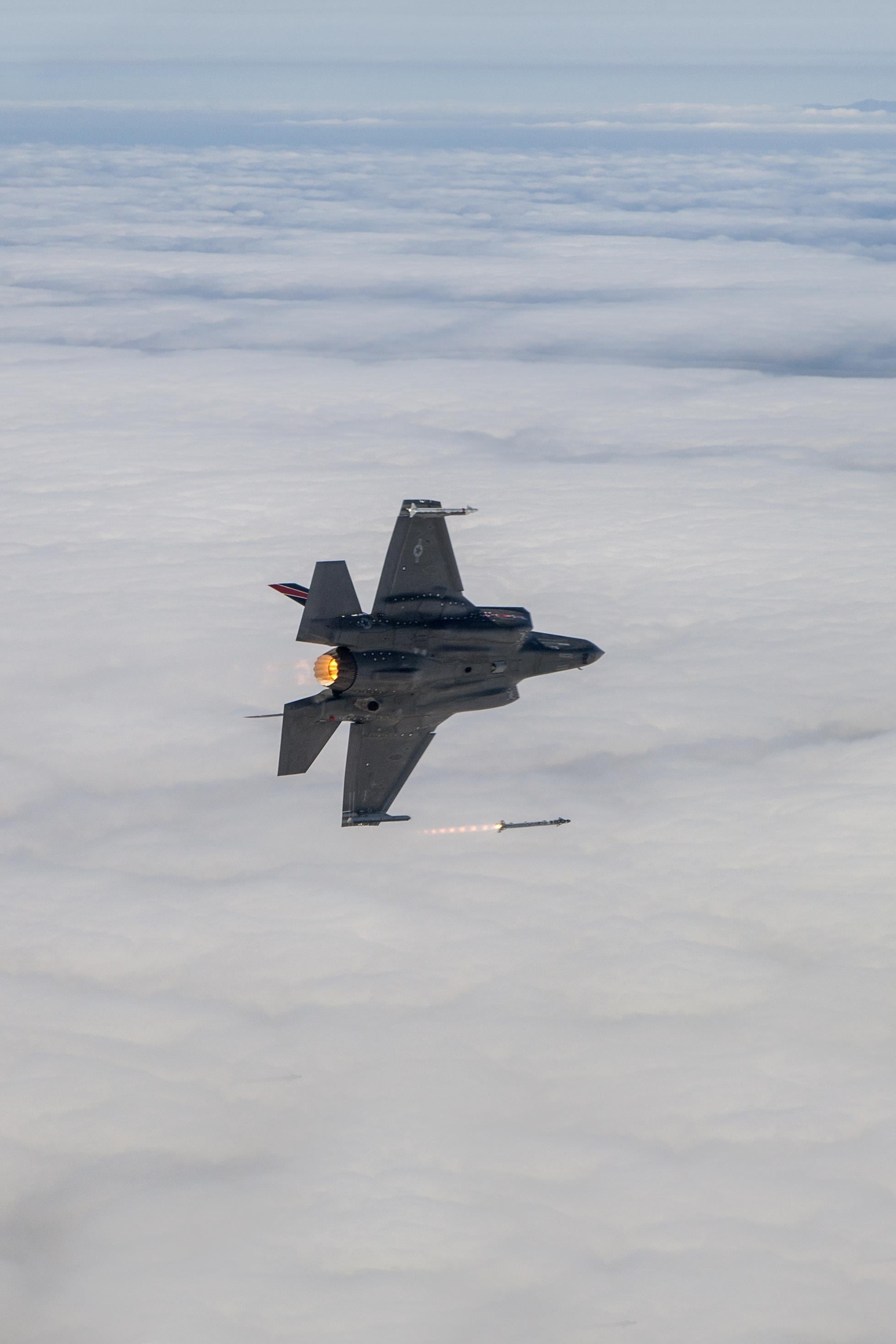By Robbin Laird
At the International Fighter Conference 2018, one of the key themes was the standup of the F-35 in several air combat forces, and the impact of this effort on the way ahead for air combat forces.
One of the presenters at the conference was an experienced F-16 pilot who had transitioned to the F-35 in 2010 and has spent several years as a USAF test pilot at Edwards Air Force base and more recently has joined Lockheed Martin in 2016 in a test pilot capacity at Edwards AFB.
I had a chance to sit down and talk with Scott “Shark” McLaren about his experience with sensor fusion on the F-35 and his perception of the combat advantages which this provides the F-35 pilot.
The baseline point is that the designers of the F-35 cockpit based on their experiences with the F-16 and the F-22 worked to provide for a visual and work system that significantly reduced the pilot load.
Then with the integrated sensor system built into the F-35 the role of data fusion is to provide situational awareness as a service to the pilot and the MADL linked combat force.
This is in contrast to a legacy fighter where the pilot is fusing the data up against a core task such as air superiority or ground attack.
In contrast, the fusion system “engine” leaves the F-35 pilot with more flexibility to perform tasks as well as operate in the words of the USAF speaker in the first morning of the conference to provide for strategic inputs as well.
“Shark” described his experience as an F-16 pilot as fusing the data from the various screens within the aircraft.
“The radar will be on one display; the targeting data on another.
“Perhaps a picture generated from the Link-16 network on another.
“You are now focused on a particular mission and putting together that data up against the core mission for which your aircraft and the formation is dedicated to executing.
“The human brain is where the information on those separate displays are being fused and translated so that pilot is able to execute the mission. And he might also be working his radio to coordinate the mission as well.
“And this is being done in a high speed combat jet where if there is a pop-up threat you might need to refocus and deal with that as your focus of situational awareness.”
The training cycle for our proficient F-16 pilot according to Shark is around 24 months to go from basic flight skills to formation flying, to learning the different mission sets and getting comfortable with delivering weapons or an effect in the different mission set environments.
And over time, as the experienced pilot flies more missions he can shape the mental mission profiles in his brain to guide the various combat missions with other combat aircraft.
“Over time, those years that I’m talking about, he’ll be able to build that mental picture, that mental model, and do most tasks, take on more responsibilities so that he can lead a two-ship, a four-ship, an eight-ship- whatever the case may be- and have enough of a mental model, based on the information coming in, to execute the mission.”
Shark added that the role of the radio is important in working the execution of missions onboard the F-16 as well which is also part of the demand side on the pilot’s attention and thinking process.
“A lot of what’s done in side a fourth-generation aircraft is done over the radio.
“That’s why I have other players maybe command and control, other tactical players that are sending me information over the radio.
“Audible communication.
“There’s no hand gestures that I can use for seeing body language, nothing. It’s just the communications that’s said over the radio, or heard over the radio.
“And now you take more time, you ask questions. And all the time that you’re doing that, that mental picture that you were supposed to be building? Your mental picture is getting disrupted.
“So when you come back to it, where is that mental picture?
“You’re probably going to drop out some of it, some of that mental picture. Some of the best pilots could keep track of it. And keep track of it pretty well.
“But even then, some of the information has dropped out.”

With this as the notional baseline, “Shark” then described the significant difference which the F-35 systems and sensor fusion can provide the pilot and the combat group.
“With the F-35, this is where the operational capability changes.
“With the F-35 you have automation via fusion going on.
“That process that is taking the F-16 pilot years to get good at, and almost all of a notional ten-minute engagement time to build a good picture, is being done automatically for the pilot in F-35 fusion.
“That picture is being built. In that same ten-minute scenario, it’s taking less than a minute for all of that information to be presented to him.
“He knows the picture.
“And that’s without any communication having to go across the formation.
“Your mental processing power which in the F-16 is focused on creating the operational mental picture or SA is now focused on combat tasks and missions.
“Your training focus also changes.
“Rather than focusing significant training time on how to shape your SA picture, you can now focus on tasks in the battlespace and distributed operations.
“The Commander and the F-35 force can focus on the effects they want to deliver in the battlespace, not just with themselves, but by empowering other combat assets as well by sharing the SA through targeting tasking.
“We have the capacity to third party target and to distribute the effects desired in the battlespace.
“That becomes our focus of training and of attention; not a primary focus on generating the SA for my organic asset to survive and to deliver a combat effect itself.
Using Shark’s 10 minute operating paradigm where the F-16 pilot is spending 8 minutes of that time period on SA and mission preparation, the F-35 pilot can spend 9 minutes of his time on mission preparation and distributed operations if so tasked.
Shark concluded: “For the F-35 pilot, training will now need to include how you go out and influence the battle area the best for the commander?
“And that’s going translate up to what the commander needs to give in direction, but also back down to what the pilot needs to know.
“And that training is part of a larger joint exercise, a larger concept of operations for the joint force which gets at the strategic impact of the F-35, which the USAF BG discussed in the conference.”
The International Fighter Conference 2018 was held from November 12-14 2018 and was organized by IQPC Germany.
Next year’s conference will be held from November 12-14 2019.
The featured photo shows Test pilot Scott McLaren launching an AIM-9X air-to-air missile during weapons surge testing. (Photo by Jonathon Case/Lockheed Martin).
For Ed Timperlake’s look at the role of combat pilots in the roll out of a new generation of combat aircraft, please see the following:
Ed Timperlake also addressed the fusion engine in the following article as well as graphic:
The F-35 as a “Flying Sensor Fusion Engine”: Positioning the Fleet for “Tron” Warfare



